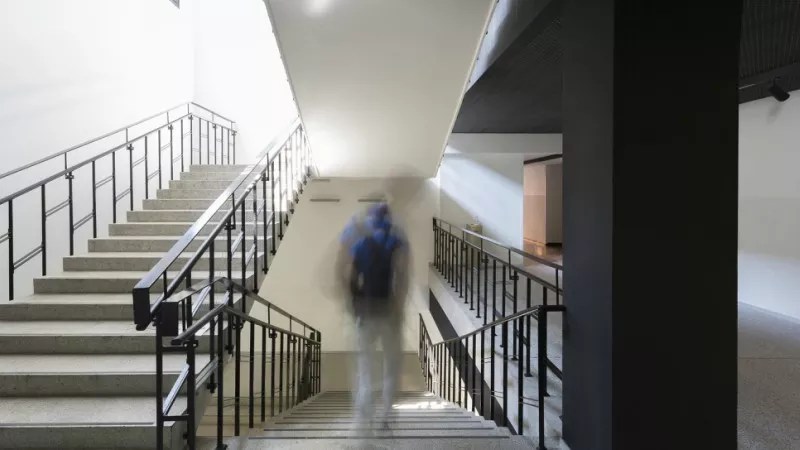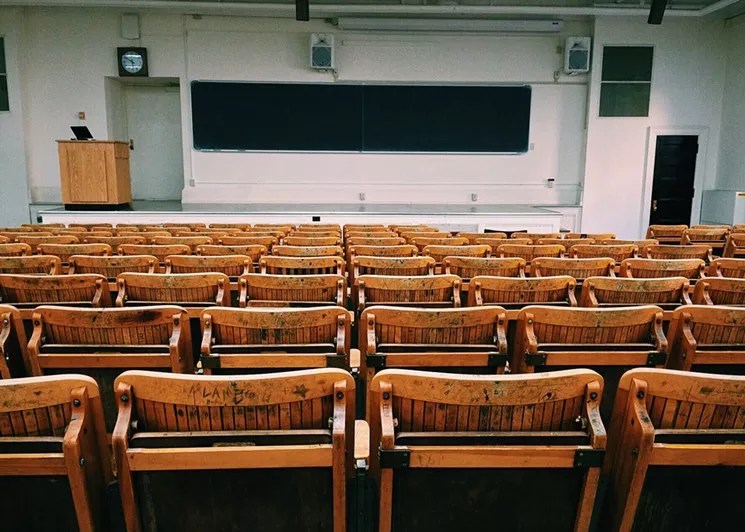
jurkos/iStock

Audio By Carbonatix
Even as teachers in Denver ready for a possible strike, new Colorado Department of Education statistics from the 2017-2018 school year boast plenty of positive news about overall graduation and dropout rates in the state.
But contained within the data are revelations about the difficulties of keeping the most vulnerable students in classrooms. Alternative schools make up the vast majority of the 25 Colorado districts with dropout rates for the previous year in excess of 10 percent. In the district with the highest rate, nearly one in three students drops out.
The CDE page related to graduation statistics shows that the four-year graduation rate for the class of 2018 was 80.7 percent – a significant jump over the figures in 2017 (79.0 percent) and 2016 (78.9 percent).
Likewise, the CDE’s dropout stats address notes that the 2.2 percent rate for the 2017-2018 term is a notch better than the 2.3 percent registered in both of the two previous years. The raw numbers are better, too, with the 10,180 dropouts in 2017-2018 bettering the totals in 2016-2017 (10,421) and 2015-2016 (10,530).
This year, make your gift count –
Invest in local news that matters.
Our work is funded by readers like you who make voluntary gifts because they value our work and want to see it continue. Make a contribution today to help us reach our $50,000 goal!
But schools and districts that specialize in alternative education face greater challenges.
The CDE notes that alternative schools “serve large percentages of students that have special needs or meet the definition of a ‘high-risk’ student. The structures and systems in these programs and schools frequently vary from traditional schools, as the student needs differentiated supports and services.”
Such programs tend to be expensive in part because they require a lower student-to-teacher ratio and they require instructors and administrators with exceptional gifts, including superhuman levels of intuition, dedication, patience and compassion. Finding and retaining such educators has always been tough, and during a time when teachers of all types are complaining about low pay and onerous working conditions, it’s not getting any easier.
That’s particularly true in rural areas, whose alternative schools make up a disproportionate number of the districts with plus-10 percent dropout rates last year. Districts in counties such as Chaffee, La Plata, Elbert and Montezuma list alternative-school pupils in the low hundreds or even fewer. In a Saguache County district, the number of such students in 2017-2018 was just sixteen.
But more populous areas are hardly immune from problems associated with keeping high-risk students in school. Also represented below are districts in Denver, Boulder and other parts of the metro area and Front Range, with four in Adams County alone. The most dropouts by sheer numbers was registered by the alternative schools in El Paso County’s Falcon 49 district: Of 4,761 total pupils, 1,186, or nearly a quarter of the total, dropped out.
For education reformers, here are 25 places to start.
Continue to see data for the aforementioned 25 districts, ordered from the lowest to the highest dropout rates over 10 percent. Click for even more details about dropouts and graduation rates in Colorado.

gpointstudio/iStock
Number 25
County: Eagle
Organization: Eagle County RE 50
District: District 3 (Alternative Schools Only)
Grade: All
Total Pupil Count: 396
Total Dropouts: 40
Total Dropout Rate: 10.10 percent
Number 24
County: Mesa
Organization: Plateau Valley 50
District: District 1 (Including Alternative Schools)
Grade: All
Total Pupil Count: 483
Total Dropouts: 52
Total Dropout Rate: 10.80 percent
Number 23
County: Adams
Organization: Adams 12 Five-Star Schools
District: District 3 (Alternative Schools Only)
Grade: All
Total Pupil Count: 1,246
Total Dropouts: 144
Total Dropout Rate: 11.60 percent
Number 22
County: Weld
Organization: Greeley 6
District: District 3 (Alternative Schools Only)
Grade: All
Total Pupil Count: 796
Total Dropouts: 93
Total Dropout Rate: 11.70 percent
Number 21
County: Chaffee
Organization: Salida R-32
District: District 3 (Alternative Schools Only)
Grade: All
Total Pupil Count: 42
Total Dropouts: 5
Total Dropout Rate: 11.90 percent
Number 20
County: La Plata
Organization: Durango 9-R
District: District 3 (Alternative Schools Only)
Grade: All
Total Pupil Count: 113
Total Dropouts: 14
Total Dropout Rate: 12.40 percent
Number 19
County: Elbert
Organization: Elizabeth C-1
District: District 3 (Alternative Schools Only)
Grade: All
Total Pupil Count: 61
Total Dropouts: 8
Total Dropout Rate: 13.10 percent
Number 18
County: Alamosa
Organization: Alamosa RE-11J
District: District 3 (Alternative Schools Only)
Grade: All
Total Pupil Count: 115
Total Dropouts: 16
Total Dropout Rate: 13.90 percent

Number 17
County: Saguache
Organization: Center 26-JT
District: District 3 (Alternative Schools Only)
Grade: All
Total Pupil Count: 14
Total Dropouts: 2
Total Dropout Rate: 14.30 percent
Number 16
County: Jefferson
Organization: Jefferson County R-1
District: District 3 (Alternative Schools Only)
Grade: All
Total Pupil Count: 1,413
Total Dropouts: 204
Total Dropout Rate: 14.40 percent
Number 15
County: Arapahoe
Organization: Englewood 1
District: District 3 (Alternative Schools Only)
Grade: All
Total Pupil Count: 401
Total Dropouts: 58
Total Dropout Rate: 14.50 percent
Number 14 (tie)
County: Colorado Boards of Cooperative Educational Services (BOCES)
Organization: Colorado Digital BOCES
District: District 2 (Excluding Alternative Schools)
Grade: All
Total Pupil Count: 2,196
Total Dropouts: 339
Total Dropout Rate: 15.40 percent
Number 14 (tie)
County: Colorado Boards of Cooperative Educational Services (BOCES)
Organization: Colorado Digital BOCES
District: District 1 (Including Alternative Schools)
Grade: All
Total Pupil Count: 2,196
Total Dropouts: 339
Total Dropout Rate: 15.40 percent
Number 12
County: Mesa
Organization: Plateau Valley 50
District: District 3 (Alternative Schools Only)
Grade: All
Total Pupil Count: 301
Total Dropouts: 50
Total Dropout Rate: 16.60 percent
Number 11
County: Chaffee
Organization: Buena Vista R-31
District: District 3 (Alternative Schools Only)
Grade: All
Total Pupil Count: 57
Total Dropouts: 10
Total Dropout Rate: 17.50 percent
Number 10
County: Adams
Organization: School District 27-J
District: District 3 (Alternative Schools Only)
Grade: All
Total Pupil Count: 334
Total Dropouts: 59
Total Dropout Rate: 17.70 percent
Number 9
County: Montezuma
Organization: Montezuma-Cortez RE-1
District: District 3 (Alternative Schools Only)
Grade: All
Total Pupil Count: 187
Total Dropouts: 36
Total Dropout Rate: 19.30 percent

Anthony Camera
Number 8
County: Denver
Organization: Denver County 1
District: District 3 (Alternative Schools Only)
Grade: All
Total Pupil Count: 4,401
Total Dropouts: 939
Total Dropout Rate: 21.30 percent
Number 7
County: Mesa
Organization: Mesa County Valley 51
District: District 3 (Alternative Schools Only)
Grade: All
Total Pupil Count: 546
Total Dropouts: 128
Total Dropout Rate: 23.40 percent
Number 6
County: El Paso
Organization: Falcon 49
District: District 3 (Alternative Schools Only)
Grade: All
Total Pupil Count: 4,761
Total Dropouts: 1,186
Total Dropout Rate: 24.90 percent
Number 5
County: Boulder
Organization: St. Vrain Valley RE-1J
District: District 3 (Alternative Schools Only)
Grade: All
Total Pupil Count: 218
Total Dropouts: 56
Total Dropout Rate: 25.70 percent
Number 4
County: Adams
Organization: Strasburg 31-J
District: District 3 (Alternative Schools Only)
Grade: All
Total Pupil Count: 15
Total Dropouts: 4
Total Dropout Rate: 26.70 percent
Number 3 (tie)
County: Colorado Boards of Cooperative Educational Services (BOCES)
Organization: Centennial BOCES
District: District 3 (Alternative Schools Only)
Grade: All
Total Pupil Count: 232
Total Dropouts: 62
Total Dropout Rate: 26.70 percent
Number 3 (tie)
County: Colorado Boards of Cooperative Educational Services (BOCES)
Organization: Centennial BOCES
District: District 1 (Including Alternative Schools)
Grade: All
Total Pupil Count: 232
Total Dropouts: 62
Total Dropout Rate: 26.70 percent
Number 1
County: Adams
Organization: Adams County 14
District: District 3 (Alternative Schools Only)
Grade: All
Total Pupil Count: 349
Total Dropouts: 112
Total Dropout Rate: 32.10 percent